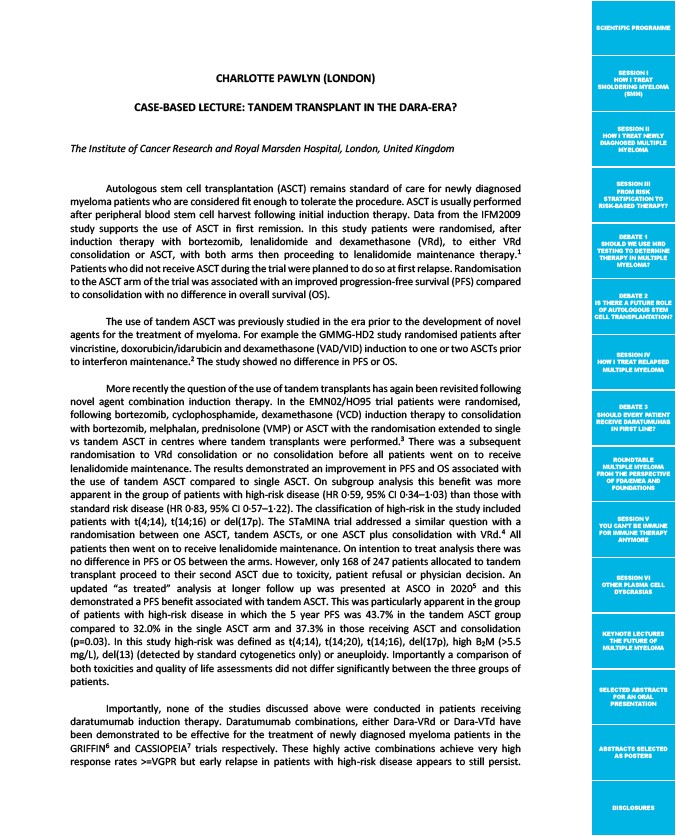
SCIENTIFIC PROGRAMME
SESSION I
HOW I TREAT
SMOLDERING MYELOMA
(SMM)
SESSION II
HOW I TREAT NEWLY
DIAGNOSED MULTIPLE
MYELOMA
SESSION III
FROM RISK
STRATIFICATION TO
RISK-BASED THERAPY?
DEBATE 1
SHOULD WE USE MRD
TESTING TO DETERMINE
THERAPY IN MULTIPLE
MYELOMA?
DEBATE 2
IS THERE A FUTURE ROLE
OF AUTOLOGOUS STEM
CELL TRANSPLANTATION?
SESSION IV
HOW I TREAT RELAPSED
MULTIPLE MYELOMA
DEBATE 3
SHOULD EVERY PATIENT
RECEIVE DARATUMUMAB
IN FIRST LINE?
ROUNDTABLE
MULTIPLE MYELOMA
FROM THE PERSPECTIVE
OF FDA/EMEA AND
FOUNDATIONS
SESSION V
YOU CAN’T BE IMMUNE
FOR IMMUNE THERAPY
ANYMORE
SESSION VI
OTHER PLASMA CELL
DYSCRASIAS
KEYNOTE LECTURES
THE FUTURE OF
MULTIPLE MYELOMA
SELECTED ABSTRACTS
FOR AN ORAL
PRESENTATION
ABSTRACTS SELECTED
AS POSTERS
DISCLOSURES
CHARLOTTE PAWLYN (LONDON)
CASE-BASED LECTURE: TANDEM TRANSPLANT IN THE DARA-ERA?
The Institute of Cancer Research and Royal Marsden Hospital, London, United Kingdom
Autologous stem cell transplantation (ASCT) remains standard of care for newly diagnosed
myeloma patients who are considered fit enough to tolerate the procedure. ASCT is usually performed
after peripheral blood stem cell harvest following initial induction therapy. Data from the IFM2009
study supports the use of ASCT in first remission. In this study patients were randomised, after
induction therapy with bortezomib, lenalidomide and dexamethasone (VRd), to either VRd
consolidation or ASCT, with both arms then proceeding to lenalidomide maintenance therapy.1
Patients who did not receive ASCT during the trial were planned to do so at first relapse. Randomisation
to the ASCT arm of the trial was associated with an improved progression-free survival (PFS) compared
to consolidation with no difference in overall survival (OS).
The use of tandem ASCT was previously studied in the era prior to the development of novel
agents for the treatment of myeloma. For example the GMMG-HD2 study randomised patients after
vincristine, doxorubicin/idarubicin and dexamethasone (VAD/VID) induction to one or two ASCTs prior
to interferon maintenance.2 The study showed no difference in PFS or OS.
More recently the question of the use of tandem transplants has again been revisited following
novel agent combination induction therapy. In the EMN02/HO95 trial patients were randomised,
following bortezomib, cyclophosphamide, dexamethasone (VCD) induction therapy to consolidation
with bortezomib, melphalan, prednisolone (VMP) or ASCT with the randomisation extended to single
vs tandem ASCT in centres where tandem transplants were performed.3 There was a subsequent
randomisation to VRd consolidation or no consolidation before all patients went on to receive
lenalidomide maintenance. The results demonstrated an improvement in PFS and OS associated with
the use of tandem ASCT compared to single ASCT. On subgroup analysis this benefit was more
apparent in the group of patients with high-risk disease (HR 0·59, 95% CI 0·34–1·03) than those with
standard risk disease (HR 0·83, 95% CI 0·57–1·22). The classification of high-risk in the study included
patients with t(4;14), t(14;16) or del(17p). The STaMINA trial addressed a similar question with a
randomisation between one ASCT, tandem ASCTs, or one ASCT plus consolidation with VRd.4 All
patients then went on to receive lenalidomide maintenance. On intention to treat analysis there was
no difference in PFS or OS between the arms. However, only 168 of 247 patients allocated to tandem
transplant proceed to their second ASCT due to toxicity, patient refusal or physician decision. An
updated “as treated” analysis at longer follow up was presented at ASCO in 20205 and this
demonstrated a PFS benefit associated with tandem ASCT. This was particularly apparent in the group
of patients with high-risk disease in which the 5 year PFS was 43.7% in the tandem ASCT group
compared to 32.0% in the single ASCT arm and 37.3% in those receiving ASCT and consolidation
(p=0.03). In this study high-risk was defined as t(4;14), t(14;20), t(14;16), del(17p), high B2M (>5.5
mg/L), del(13) (detected by standard cytogenetics only) or aneuploidy. Importantly a comparison of
both toxicities and quality of life assessments did not differ significantly between the three groups of
patients.
Importantly, none of the studies discussed above were conducted in patients receiving
daratumumab induction therapy. Daratumumab combinations, either Dara-VRd or Dara-VTd have
been demonstrated to be effective for the treatment of newly diagnosed myeloma patients in the
GRIFFIN6 and CASSIOPEIA7 trials respectively. These highly active combinations achieve very high
response rates >=VGPR but early relapse in patients with high-risk disease appears to still persist.